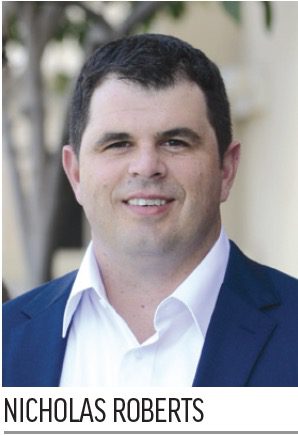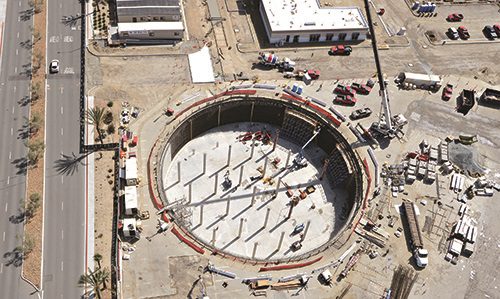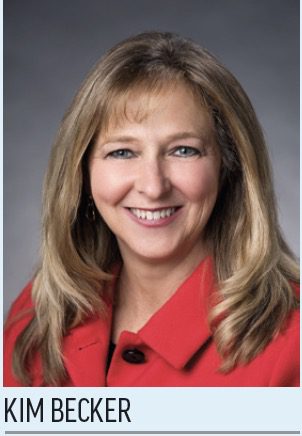San Diego International Airport (SAN) recently raised its lofty sustainability bar a few notches higher by adding a new, award-winning element to its stormwater management system. The $38 million project, completed in November 2020, features a large concrete cistern that collects runoff from the northside airfield.

San Diego International Airport (SAN) recently raised its lofty sustainability bar a few notches higher by adding a new, award-winning element to its stormwater management system. The $38 million project, completed in November 2020, features a large concrete cistern that collects runoff from the northside airfield. The water it captures will be treated and reused to wash rental cars—a science-driven approach that garnered a 2020 Environmental Excellence Award from the Industrial Environmental Association.
The 3.2 million-gallon cistern is designed to reuse 16 million gallons of captured stormwater per year at SAN’s rental car center, which washes about 4,000 cars daily.
“Right now, all these cars are washed using potable water,” explains SAN Vice President and Chief Development Officer Dennis Probst. “The savings will be quite significant.“
The new cistern joins another stormwater capture and reuse system built a few years ago at the Terminal 2 parking facility. It can hold approximately 100,000 gallons and feeds water to the airport’s cooling towers, which require 35,000 to 50,000 gallons per day.
|
Project: Stormwater Cistern Location: San Diego Int’l Airport Strategy: Capture northside airfield runoff for reuse at car wash facility Cost: $38 million Funding: Airport revenue bonds Design & Construction: Dec. 2018-Nov. 2020 Cistern Capacity: 3.2 million gallons General Contractor: Sundt Construction Cistern Design & Structural Engineering: Carollo Engineers Stormwater Drainage Design: C&S Companies Geotechnical Engineering: Group Delta Architecture & Design Coordination: HOK Secant Pile Contractor: Condon Johnson Dewatering System: Pure Effect Of Note: System won 2020 Environmental Excellence Award from Industrial Environmental Association |
Although the new cistern will primarily supply water to the car wash, Probst notes that it could also send water to the cooling towers in the future. At this point, the jury is still out regarding how much.
Both stormwater capture/reuse systems are part of SAN’s ongoing water stewardship plan. Other key elements associated with the north side include:
- two infiltration beds with 2.65 acres of surface area,
- underground storage and infiltration chambers capable of holding 640,000 gallons, and
- bioswales for cleaning and channeling stormwater infiltration.
“We’re working very hard, piece by piece, to capture and reuse as much stormwater runoff as we can to keep it out of the (San Diego) Bay,” Probst explains.
Planning Ahead
The new northside cistern will help SAN comply with National Pollutant Discharge Elimination System permits by collecting 80% of the airport’s average annual runoff. Typically, San Diego receives about 10 inches per year, most of which falls in January, February and March.
Maintaining water quality is a significant issue throughout Southern California. At SAN, copper and zinc pollutants from aircraft braking and chain link security fencing are particular issues that will soon be even more challenging. Probst explains that regulations about how much copper and zinc can be discharged into San Diego Bay will tighten in 2026 to approximately 1/1,000 of what is acceptable for human health. Human health requirements are often measured in parts per million; what will be allowed into the Bay after 2026 will be measured in parts per billion, he notes.
“There’s no way we would be able to treat the water at those contaminant levels,” Probst informs. “If we had waited until 2026 to confront these issues, our Terminal 1 development program would be completed and we would have to go back in and tear things up. We’re advancing all of this sustainability work as part of the development program for the new terminal.”
Easier Said Than Done
The new cistern will eventually collect runoff from 78 acres of the northside airfield. Constructing the 28-foot deep, 160-foot diameter concrete cistern in a limited space without significantly impacting airport operations was no easy task for the project’s general contractor.
 “The biggest challenge was determining how to dig a 35-foot hole in an area where the water table is only 7 to 8 feet below the surface,” notes Brad Kirsch, project director for Sundt Construction. “The sheer size of the cistern and the amount of dewatering to keep the area dry throughout construction presented a major challenge. You can’t construct a tank like this in the middle of a big muddy puddle. We had to find a shoring system that would allow us to create a cutoff.”
“The biggest challenge was determining how to dig a 35-foot hole in an area where the water table is only 7 to 8 feet below the surface,” notes Brad Kirsch, project director for Sundt Construction. “The sheer size of the cistern and the amount of dewatering to keep the area dry throughout construction presented a major challenge. You can’t construct a tank like this in the middle of a big muddy puddle. We had to find a shoring system that would allow us to create a cutoff.”
Work on the design-build project began in December 2018 and finished up in November 2020. Sundt hired Carollo Engineers to provide design and engineering services. Carollo Project Manager Miko Aivazian presented multiple cistern design options for Sundt and airport officials to compare and consider. Eventually, the team settled on a circular cast-in-place concrete cistern with a secant shoring system.
“The secant shoring system was key,” Aivazian states. “Secant piles were selected to meet the smaller footprint requirements and help reduce the amount of water seeping into the excavation pit. A dewatering/pumping system was designed to continuously dewater the excavation pit. The 180 four-foot-diameter secant piles were also used as formwork for the 28-foot cistern walls, but they were kept independent from the walls due to differential settlement between the secant piles and cistern walls.”
 The cistern’s 3-foot concrete mat slab floor is anchored in place by 185 piles, each 16 inches in diameter. These piles hold the weight of the water, but also anchor the cistern in place when it is empty. The concrete roof is supported by 32 interior columns, each 24 inches in diameter.
The cistern’s 3-foot concrete mat slab floor is anchored in place by 185 piles, each 16 inches in diameter. These piles hold the weight of the water, but also anchor the cistern in place when it is empty. The concrete roof is supported by 32 interior columns, each 24 inches in diameter.
“The auger-displacement piles were drilled 50 feet below the slab,” Kirsch adds. “We had to lower a drill rig into the 35-foot pit with a large crane. I had never lifted a drill rig that large down into an excavation like this before.”
 The new stormwater drainage system that feeds the cistern, designed and installed by C&S Companies, includes 3,500 linear feet of 24- to 54-inch pipe, much of which is deep and within the groundwater table. Managing Engineer Nicholas Roberts explains that the company had to reroute the existing storm drain system because a lot of it was located in older deep storm drain pipes connected to bay outfalls. “We also had to cross and disconnect from large diameter storm drains conveying flows from outside the airport that passed through the airport property,” he adds. “We basically had to identify and navigate over and under large diameter pipes, which was a big task from a gravity perspective. To alleviate construction impacts, we scoured old records (circa 1940s) and potholed to the extent possible but had to identify and make adjustments a portion of the system during construction.”
The new stormwater drainage system that feeds the cistern, designed and installed by C&S Companies, includes 3,500 linear feet of 24- to 54-inch pipe, much of which is deep and within the groundwater table. Managing Engineer Nicholas Roberts explains that the company had to reroute the existing storm drain system because a lot of it was located in older deep storm drain pipes connected to bay outfalls. “We also had to cross and disconnect from large diameter storm drains conveying flows from outside the airport that passed through the airport property,” he adds. “We basically had to identify and navigate over and under large diameter pipes, which was a big task from a gravity perspective. To alleviate construction impacts, we scoured old records (circa 1940s) and potholed to the extent possible but had to identify and make adjustments a portion of the system during construction.”
Water Reused = Money Saved
Probst categorizes the financial benefits of the cistern project—and the rest of SAN’s stormwater capture/reuse system—into two general categories: money saved and costs avoided.
For instance, washing rental cars with captured stormwater will allow the airport to purchase less tap water, which costs about ½ cent per gallon in San Diego. For every 10 million gallons of captured stormwater it uses, SAN can save roughly $50,000.
Avoiding regulatory penalties could have even larger implications—especially those involving National Pollutant Discharge Elimination System (NPDES) requirements, as enforced by the state of California. Probst explains that even though the stormwater draining from the airport meets U.S. Environmental Protection Agency drinking water standards, it also must meet more stringent NPDES standards. Fines for infractions, issued on a per gallon or per day basis, can become prohibitive; and associated enforcement actions can require significant staff time and disrupt future development projects, notes Probst.
“Our stormwater capture and reuse system is intended to future-proof the airport from regulatory changes associated with the stormwater discharge,” he adds, noting that the new northside cistern is just one element of SAN’s overall water stewardship plan.
Other components yet to be constructed include a large cistern to collect stormwater runoff associated with the airport’s new Terminal 1, which is expected to begin construction in 2021. Additional storage tanks and below-grade infiltration systems are also in the works. Following treatment, southside runoff will likely be used to flush toilets in the new terminal and sent to the airport’s central utility plant as an additional source of water for the cooling towers—uses that do not require potable water.
“If we’re not the best airport in the country as it relates to sustainability and environmental practices, we’re certainly in the top tier,” Probst proudly relates. “We have a great team doing great work here at the airport, and I’d put them up against anybody in the country.”
|
From Puddles to Beer
Throughout the years, San Diego International Airport (SAN) has executed several programs to conserve and recycle water, but one really flexes the bounds of environmental creativity. It managed to transform moisture dripping from the pre-conditioned air units under boarding bridges into beer—and a popular brew at that. Airport personnel began capturing the dripping condensate back in 2014, and now collect about 100,000 gallons per year from 18 of the busiest jet bridges in terminals 1 and 2. In summer 2018, Water Works Inc., a local water purification company, advised SAN that the condensate’s excellent quality would be conducive for brewing beer. In addition to embracing the minor revenue potential, airport officials saw a unique opportunity to educate the public about SAN’s water conservation efforts. In mid-September, the Airport Authority agreed to collaborate with Ballast Point, a local brewery, to make a craft beer; and the tasty green project was fully in motion. Although the condensate is very pure and comparable to distilled water, Water Works further purified approximately 200 gallons of condensate water from SAN using an ozone disinfection process. Then Ballast Point ran the purified water through carbon and 5-micron filters before brewing it into beer. The final product, aptly named SAN Test Pilot, is characterized as a “light and crisp beer that allows the water to shine through.” Because SAN’s reclaimed water has a much lower mineral content than water from the municipal supply, it provided an ideal base for the brewers. Beginning with a blank slate allowed them to carefully adjust the water’s mineral content, pH and flavor with brewing salts for specific results. Tasters say the Ballast Point recipe has fruity esters similar to a ripe pear, and its Spalt hops produce a sharp citrus zest finish. Quite a transformation from condensation puddling on the tarmac.
Although the current COVID pandemic put the brakes on further condensate-to-beer production, Airport Authority officials look forward to exploring new ventures in the future. “The airport is always striving to enhance our sustainability efforts and find unique ways to use the reclaimed water we capture,” Airport Authority President and Chief Executive Officer Kim Becker said in a press release. “This beer reaffirms our commitment to sustainability in a truly fun and innovative way.” SAN also uses condensate produced by the pre-conditioned air units to power-wash sidewalks in front of the terminals, and to clean airside vehicles, equipment and bins that collect food waste for composting—another one of the airport’s noteworthy environmental programs. |


 facts&figures
facts&figures

 When the limited edition supply of SAN Test Pilot debuted at three local pubs, the entire 139-gallon batch sold out in less than 10 days.
When the limited edition supply of SAN Test Pilot debuted at three local pubs, the entire 139-gallon batch sold out in less than 10 days.

